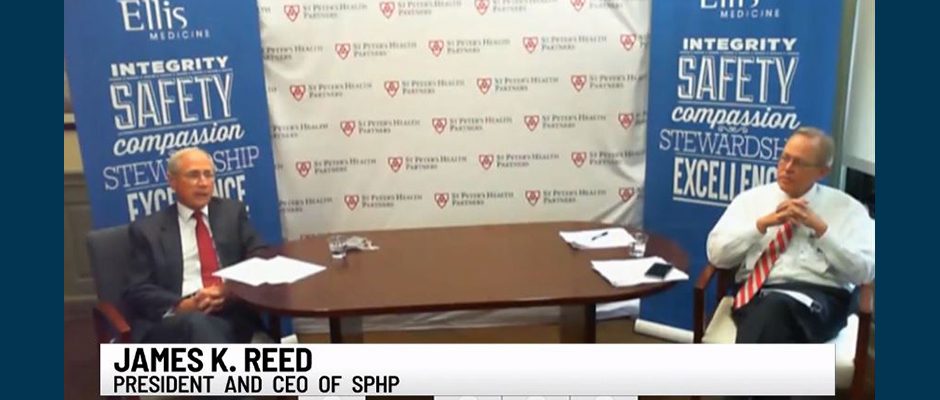
The Federal Trade Commission (FTC) has completed its review of the merger of Northeast Health, St. Peter’s Health Care Services and Seton Health and decided not to challenge the merger, officials of the three healthcare organizations announced today. The FTC action represents a significant milestone for the final transaction to combine the three organizations.
In letters dated April 27, 2011, to each of the three organizations, the Federal Trade Commission said, “Upon further review of this matter, it now appears that no further action is warranted by the Commission at this time. Accordingly, the investigation has been closed.”
Officials from the three organizations said they expect that the transaction to create the new merged health system will now be finalized late this summer. The officials said that work has begun to prepare the legal and financial documents necessary to complete the transaction.
The actual merger transaction later this year will create a new not-for-profit organization to become the “parent corporation” for the Northeast, St. Peter’s and Seton health systems. It will be governed by a board structure with membership drawn from all three organizations. While the new organization will be formed and begin actual operation later this year, full integration may take approximately three years.
The announcement was made at a press conference today that included: Steven Boyle, president, CEO, St. Peter’s Health Care Services; James Reed, MD, president & CEO, Northeast Health; and Scott St. George, interim president & CEO, Seton Health.
“The FTC’s decision represents the last major regulatory process that needed to be concluded for us to complete the affiliation we first announced in February 2009,” said Boyle. “The nearly yearlong FTC examination included the review of hundreds of thousands of documents from the three organizations and consumed significant amounts of staff time from all of the parties. The FTC review follows a similarly exhaustive self-examination or ‘due diligence’ which the organizations completed before signing the Affiliation Agreement, and which found that a merger of the organizations is in the best interest of the communities served by the institutions.”
Dr. Reed of Northeast Health said, “We believe that by combining our complementary strengths, we can significantly improve our ability to meet the health care needs of the region. Our primary goal will be to reduce fragmentation of patient care, a fundamental flaw in the American health care system. Focusing on care coordination will lead to higher quality, increased efficiency and improved access. We are excited that the payors have expressed a desire to work with us to develop and implement new and innovative health care delivery and reimbursement models that will meet our mutual goal to reform health care at the local level.”
“Several years ago, our boards imagined a better way to provide health services for the greater Capital Region and beyond,” said St. George of Seton. “Today’s announcement brings us one step closer to creating a health system that will increase access to high-quality care and improve the wellbeing of our neighbors. Our three organizations have long legacies of providing excellent care while continuously adapting to changing community needs. This is a tribute to the dedicated associates and physicians who everyday help us carry out our missions. We now have an opportunity to combine our strengths to create an organization that continues these traditions with increased creativity and renewed commitment.”
The FTC review was routine and expected. The FTC began its review in June 2010, after the formal Affiliation Agreement was signed.
To ensure that the institutions fully met the FTC’s request for data related to the assessment, officials from Northeast Health, St. Peter’s and Seton Health retrieved and searched through nearly eight million paper and electronic documents – with an average length of six pages per document. Eventually about 100,000 documents were submitted to the FTC to meet their request.
The FTC decision also means that the three organizations can now begin a final Planning and Integration Process that will bring the Affiliation Agreement and a conceptual design of the new health system to an operational level. Despite having signed the binding Affiliation Agreement last year, regulatory barriers still prevented the organizations from sharing with one another such sensitive information as pricing, salaries, benefits, market share, and other key operational data necessary to complete the merger.
Significant progress has been made in the process to select a name and identity for the new company, but work continues. Recommendations from this process will be presented to the Boards of the three organizations this summer. Implementation of the new identity will not occur until the new corporation is formed by the final merger transaction.
The merger – which has been billed as “health care reform at the regional level” – will better allow the organizations to combine their complementary strengths and better meet the sweeping challenges of federal health care reform.
Planning and Integration Process
With the FTC decision, the Planning and Integration Process can now begin immediately. Planning and Integration Workgroups will be formulated in the next few weeks.
A permanent senior management structure for the new health system will also soon be developed as part of the planning and integration phase.
With guidance from senior management, these workgroups will recommend and prioritize what functions and services must be integrated and what changes must be made for the merger to be completed. Action plans will be developed to complete the highest priority activities.
Beginning Implementation of System Design
The overall goal of the Planning and Integration Process will be to implement a preliminary “blueprint” of the new health care system that was developed in 2010. A key aspect of the plan is the estimated investment of $55 million in facilities and information technology upgrades – nearly $6 million in information technology and nearly $50 million in facility upgrades at the two Troy hospitals and Albany Memorial Hospital. Troy will also benefit from the availability of more sophisticated cardiac services and a new outpatient cancer treatment center.
The proposed design of the new health system includes the reconfiguration and merging of certain services, particularly in the four acute care hospitals which will make up the new system — St. Mary’s and Samaritan hospitals in Troy, and Albany Memorial and St. Peter’s hospitals in Albany.
All four acute care hospitals will continue to operate under the proposed plan, as will Sunnyview Rehabilitation Hospital in Schenectady. While the new corporation is expected to be formally created this summer, it could take as many as three years for the new health care system to complete many of the changes and to fully integrate the three current health systems.
Top leaders of the new company will include Steven P. Boyle, president, CEO of St. Peter’s Health Care Services, who will be CEO of the new organization; and James Reed, MD, currently president & CEO of Northeast Health, who will be the President of the new company. Both will report directly to the new Board of Trustees.
This new company will be a member of Catholic Health East, the current parent corporation of St. Peter’s Health Care Services, and will abide by the Ethical and Religious Directives of the Catholic Church. However, the new company will not be a Catholic entity. St. Peter’s and Seton will retain their Catholic identities and Northeast Health will remain a secular organization.
Design for System and New Configuration for Hospitals
With nearly 12,000 employees in more than 125 locations, the three systems currently provide a wide array of services to thousands of people each day. These services include: St. Peter’s Hospital’s state-of-the-art tertiary care services, its Community Hospice, home care, addiction recovery center, and two skilled nursing facilities; and Northeast’s Albany Memorial and Samaritan hospitals, and Sunnyview Rehabilitation Hospital. It also includes The Eddy’s renowned eldercare services including skilled nursing, Alzheimer’s, adult day services, home care and community services, and retirement and assisted living. Seton adds St. Mary’s Hospital, a skilled nursing facility, certified home care agency, 14 physician office locations and an array of specialty services.
Under the draft System Design, reconfiguring care, programs and services will require significant investment in renovation and enhancements of the hospitals and other facilities. These include the construction of a new Outpatient Cancer Treatment Center at St. Mary’s Hospital, as well as renovations and other investments at Albany Memorial, Samaritan and St. Mary’s to support the merging and transfer of certain services. St. Peter’s Hospital is already completing a $258 million, multi-year renovation and construction program scheduled to be completed in 2013. The St. Peter’s project will renovate or replace most of the hospital’s main campus.
Prior to the final affiliation transaction, Northeast is creating a separate health care entity at Samaritan Hospital to provide pre-natal care, birthing and sterilization procedures (tubal ligations and vasectomies). Known as the Burdett Care Center (BCC), it will be a separately licensed, independent hospital governed by its own board.
The New York State Department of Health approved the Certificate of Need application for BCC last year and construction has been completed. BCC must be operational before the merger between St. Peter’s, Northeast Health and Seton Health can be finalized. A time line is being developed to consolidate St. Mary’s maternity services at BCC following the merger.
Other key aspects in hospital reconfiguration that will take place over time include:
Samaritan Hospital:
- In one of the most significant reconfigurations, Samaritan Hospital will become the inpatient medical/surgical provider in Troy including medical, surgical and critical care beds. It would also have inpatient and outpatient surgery, emergency services, endoscopy, imaging, and other diagnostic, treatment and support services. Inpatient medical/surgical beds from St. Mary’s would move to the Samaritan campus. Since Troy needs only one cardiac catheterization laboratory, that facility would be located at Samaritan and would have new capabilities to perform angioplasty (opening of heart arteries with a balloon or stent). The facility would be integrated with St. Peter’s Cardiac and Vascular services.
- Samaritan was selected as the medical/surgical location due to its larger overall bed capacity, larger OR suite, and larger and more flexible site plan. It also requires less immediate investment in capital improvements.
St. Mary’s Hospital:
- St. Mary’s Hospital becomes a focal point for the new system’s behavioral health program, as well as a consolidated ambulatory center that will include a new cancer treatment facility for Rensselaer County. Behavioral health services currently at Samaritan and inpatient substance abuse beds currently at St. Peter’s will move to St. Mary’s Hospital. Emergency services, as well as diagnostic, treatment and various support functions, will also continue at St. Mary’s.
- The new Cancer Treatment Center at St. Mary’s will offer radiation therapy, infusion and psychosocial support services. In addition to the Ambulatory Center, St. Mary’s will also provide select surgical services; endoscopy; imaging; cardiac rehab; outpatient physical and occupational therapy; sleep studies; as well as clinics and primary care. In its behavioral health programs, St. Mary’s will provide adult psychiatric services. There will also be chemical and substance abuse services, including outpatient services, counseling and detox.
Albany Memorial Hospital:
- Albany Memorial Hospital will continue as a community hospital with a specialty-focused, surgical program including inpatient medical, surgical, critical care and emergency services. It will also provide additional ambulatory and short-stay surgery (less-complex surgery that requires a shorter length of stay in the hospital).
St. Peter’s Hospital:
- St. Peter’s Hospital will be the system’s provider of specialized (tertiary) care for all medical specialties in the new corporation, including complex inpatient care such as cardiovascular care, cancer care, women’s & children’s services (including NICU), neurosurgery, orthopedic, urology and GI among others.
- St. Peter’s will also address the region’s need for a recognized comprehensive cancer center. Some inpatient services at St. Peter’s, such as physical medicine rehabilitation and substance abuse, will be transferred to other members of the new health system.
In addition to changes in the system’s hospitals, all of the new system’s sub-acute and acute rehabilitation, long-term care, home care, retirement housing and hospice care will be organized under The Eddy. The institutions’ respective charitable giving foundations would also continue as currently structured.
No Immediate Impact on Operation of Facilities or Staff
In order to accomplish transformational change, there will be an impact on jobs. No disruption of staff or management personnel is expected during the Planning and Integration process. Many of the changes require Certificate of Need approval or other regulatory approval. Some involve significant construction and/or renovation. Most changes would likely occur over a three-year period following the merger.
In a joint statement, the hospital CEOs said, “The primary reason for this affiliation is not to reduce jobs. Northeast, St. Peter’s, and Seton are affiliating to explore health care reform – to improve when, where, and how care is provided. Our goal is to retain skilled individuals – perhaps some performing different jobs, some in different locations – in a more stable organization and work environment. Although services and programs may move, patients still need to be cared for regardless of physical location.”
“In the event that there are job reductions, employees will be treated fairly and compassionately. Reductions in FTEs will likely be mitigated by annual attrition rates of 10 to 12 percent.”
The proposed affiliation is not expected to disrupt physician practices at any hospital operated by St. Peter’s, Northeast or Seton. Medical staff governance will continue to respect the unique practice circumstances of each participating hospital. It is believed a combined organization will help recruit new physicians to the Capital Region, a true community need.





